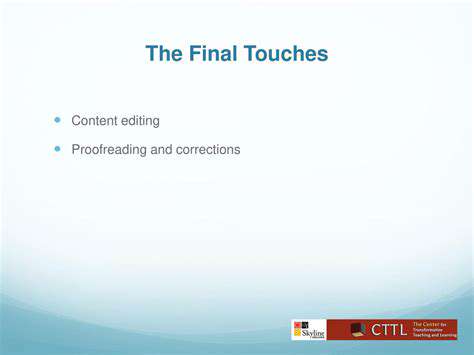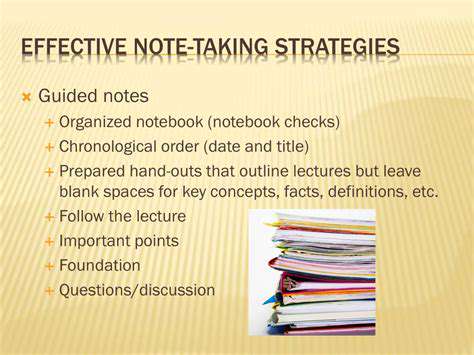Tips for Writing a Personal Statement for Graduate School
Crafting a Compelling Narrative
A strong personal statement isn't just a list of accomplishments; it's a compelling narrative that showcases your unique journey and aspirations. Think about the specific program you're applying to and how your experiences align with its values and goals. Highlight the specific aspects of the program that resonate with you, demonstrating that you've done your research and are genuinely interested in the program's offerings. This personalized approach helps distinguish you from other applicants who might have similar qualifications but lack this focused understanding.
Your story should flow logically, weaving together your experiences, motivations, and future aspirations. This narrative approach allows the admissions committee to connect with you on a deeper level, understanding not just what you've done, but why you've done it and what you hope to achieve.
Highlighting Relevant Skills and Experiences
Don't just summarize your resume; showcase how your skills and experiences directly relate to the program's requirements and objectives. For example, if the program emphasizes teamwork, describe a project where you collaborated effectively with others. If the program focuses on critical thinking, detail a situation where you analyzed a complex problem and arrived at a sound solution. This demonstrates how your past actions have prepared you for the challenges of the program.
Provide concrete examples to illustrate your points. Quantify your achievements whenever possible. Instead of saying I was a leader, say I led a team of five students to successfully complete a project that exceeded expectations by 15%. These specific examples paint a vivid picture of your capabilities and demonstrate your impact.
Demonstrating a Passion for the Field
The admissions committee wants to see that you're genuinely passionate about the field of study. Don't just state your interest; show it through your experiences, research, and interactions with the field. Describe specific instances where you've been inspired by the work of relevant professionals, or how you've actively sought out opportunities to learn more about the subject matter.
Your passion should be evident throughout the statement, not just in a single paragraph. Show, don't just tell, your enthusiasm. Connect your personal interests to the broader field of study and explain how you envision your future contributions to the discipline. This demonstrates your commitment and intellectual curiosity beyond the application itself.
Addressing Potential Weaknesses or Challenges
If you have any areas where your qualifications might seem less compelling, address them thoughtfully and constructively. Don't shy away from discussing any challenges you've faced, but focus on how you overcame them and what you learned from the experience. This demonstrates resilience and a growth mindset, qualities highly valued by admissions committees.
Frame any weaknesses as opportunities for growth and learning. Explain how these experiences have shaped your perspective and informed your aspirations for the future. By acknowledging and addressing these aspects, you show a more complete and authentic picture of yourself.
Showcasing Your Unique Perspective
In a competitive application pool, it's crucial to stand out. What makes you unique? What perspectives do you bring to the table that others don't? Highlight your unique experiences, perspectives, and experiences that set you apart from other applicants. This could be anything from your cultural background to your personal interests, from volunteer work to your involvement in extracurricular activities.
Explore your passions and how they intersect with the program's goals. Share your perspectives and ideas in a way that demonstrates your intellectual curiosity and your potential to contribute meaningfully to the academic community.
Proofreading and Editing
A well-crafted personal statement is more than just a collection of ideas; it's a meticulously polished piece of writing. Thorough proofreading and editing are crucial to ensure clarity, conciseness, and coherence. Pay close attention to grammar, punctuation, and style. Seek feedback from trusted mentors, professors, or peers to identify areas for improvement.
Ensure your statement is free of errors and flows smoothly. A polished statement conveys professionalism and attention to detail. Consider having a professional editor review your statement before submitting it to ensure it is error-free and presents you in the best possible light.
Considering the Program's Specific Requirements
Each program has its own unique set of requirements and expectations for personal statements. Carefully review the program's guidelines and instructions to ensure your statement adheres to these specifications. Pay attention to word limits, formatting requirements, and any specific themes or questions the program asks you to address. A statement that fails to meet these basic requirements will likely be overlooked.
Understanding and adhering to the program's specific requirements demonstrates your respect for their process and your commitment to the application. This meticulous attention to detail showcases your preparedness and reinforces your seriousness about pursuing admission to the program.

Proofreading and Refining: The Final Touches

Proofreading for Clarity and Conciseness
Effective proofreading goes beyond simply catching typos. A crucial aspect of the process is ensuring the writing is crystal clear and concise. This means removing unnecessary words and phrases that don't contribute to the overall message. Redundancy and wordiness can confuse the reader and detract from the impact of the piece. By striving for clarity, the writer ensures that the intended meaning is easily understood and that the text flows smoothly.
Careful attention to sentence structure and paragraph organization also contributes to clarity. Long, rambling sentences can be difficult to follow. Breaking them down into shorter, more manageable units improves readability and comprehension. Similarly, well-structured paragraphs, each focusing on a single idea, guide the reader through the text and enhance understanding.
Identifying and Correcting Grammatical Errors
Grammar errors, while seemingly small, can significantly impact the credibility and overall effectiveness of a piece. A well-written piece is free of grammatical mistakes, ensuring the text is professional and polished. Errors in subject-verb agreement, tense consistency, and pronoun usage can undermine the author's authority and leave a negative impression on the reader.
Thorough proofreading involves a keen eye for these grammatical pitfalls. Checking for proper punctuation, including commas, semicolons, and colons, is also essential. These seemingly minor details contribute greatly to the overall quality of the writing.
Revising for Style and Tone
A key aspect of refining a piece is ensuring the style and tone are appropriate for the intended audience and purpose. A formal tone might be necessary for academic writing, while a more conversational style might be suitable for a blog post. Maintaining a consistent tone throughout the text helps create a cohesive and engaging reading experience.
Considering the audience and purpose is crucial for achieving the desired impact. A well-crafted piece speaks directly to the reader, engaging them and leaving a lasting impression.
Addressing Logical Inconsistencies and Flaws
Logical fallacies and inconsistencies can undermine the argument or message of a piece. Carefully reviewing the text for logical flow and coherence is essential for presenting a persuasive and well-reasoned argument. Identifying and resolving these inconsistencies strengthens the overall message and enhances the credibility of the author.
Proofreading should involve a critical evaluation of the text's logic. Are the arguments presented effectively? Do they flow logically from one point to the next? Identifying any gaps in the logic or reasoning helps clarify the message and make the writing more persuasive.
Fact-Checking and Verifying Information
In many types of writing, accuracy is paramount. Whether it's a research paper, a news report, or a historical account, verifying the facts is critical. Incorrect or outdated information can damage the credibility of the piece and undermine the author's expertise. Taking the time to research and confirm information is essential for maintaining the accuracy and integrity of the writing.
Consulting reliable sources and double-checking data are key aspects of ensuring factual accuracy. This process involves thorough research and a commitment to presenting information that is both accurate and up-to-date. By paying close attention to detail and verifying sources, the writer ensures the piece is trustworthy and reliable.
Ensuring Consistency in Style and Formatting
Consistent formatting and style are crucial for professional-looking documents. This includes using a consistent font, font size, and line spacing throughout the piece. Maintaining a consistent style and format creates a polished and professional appearance.
This also applies to citations, use of headings, and other formatting elements. Maintaining consistency streamlines the reading experience and improves the overall presentation of the content. A consistent style and format ensures the piece is easy to read and understand.
Read more about Tips for Writing a Personal Statement for Graduate School
Hot Recommendations
- How to Stay Productive While Working Remotely
- Tips for Managing Conflict with Coworkers
- Entrance & Certification Exams (升学考试)
- How to Improve Your Storytelling Skills (Speaking)
- How to Find Profitable Side Hustles
- Tips for Preparing for the TOEFL iBT Home Edition
- Guide to Switching Careers from [Industry A] to [Industry B]
- How to Run an Effective Hybrid Meeting
- Tips for Marketing Your Side Hustle on Instagram











